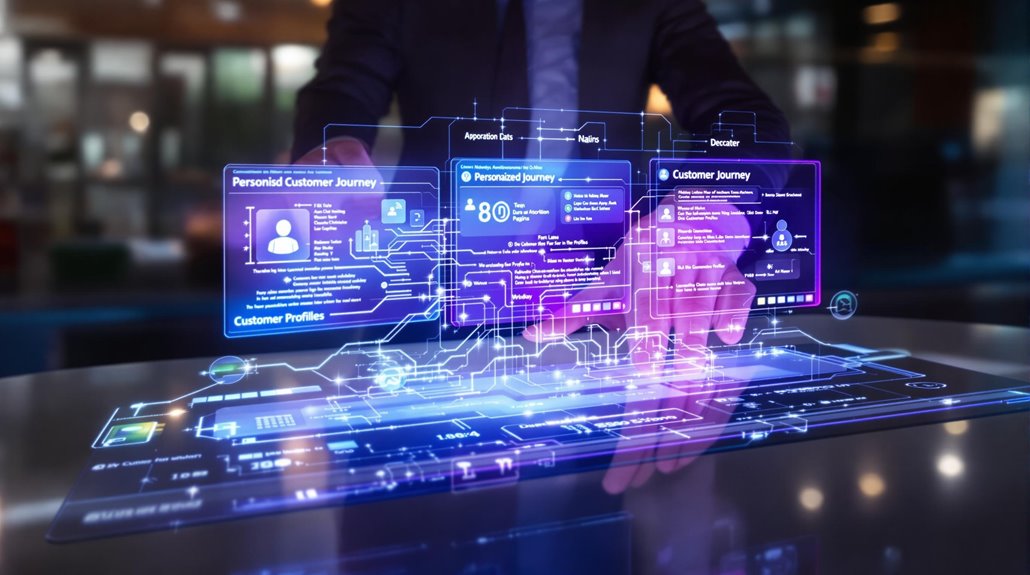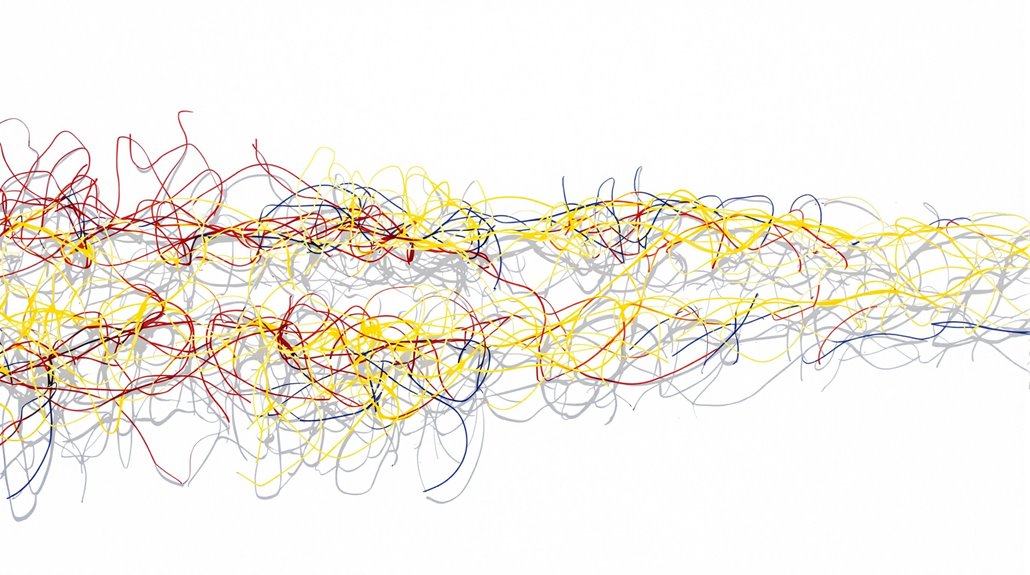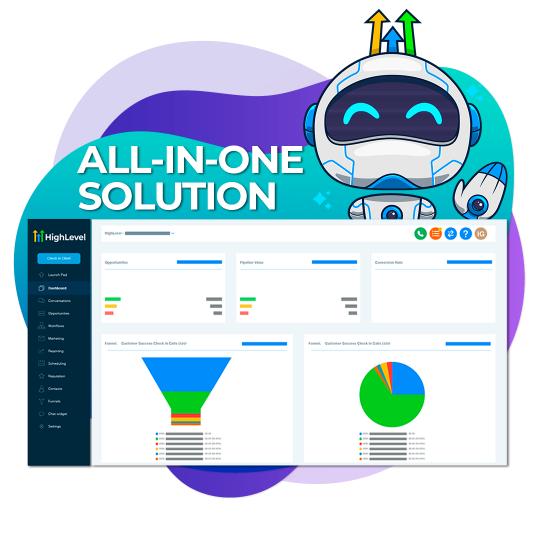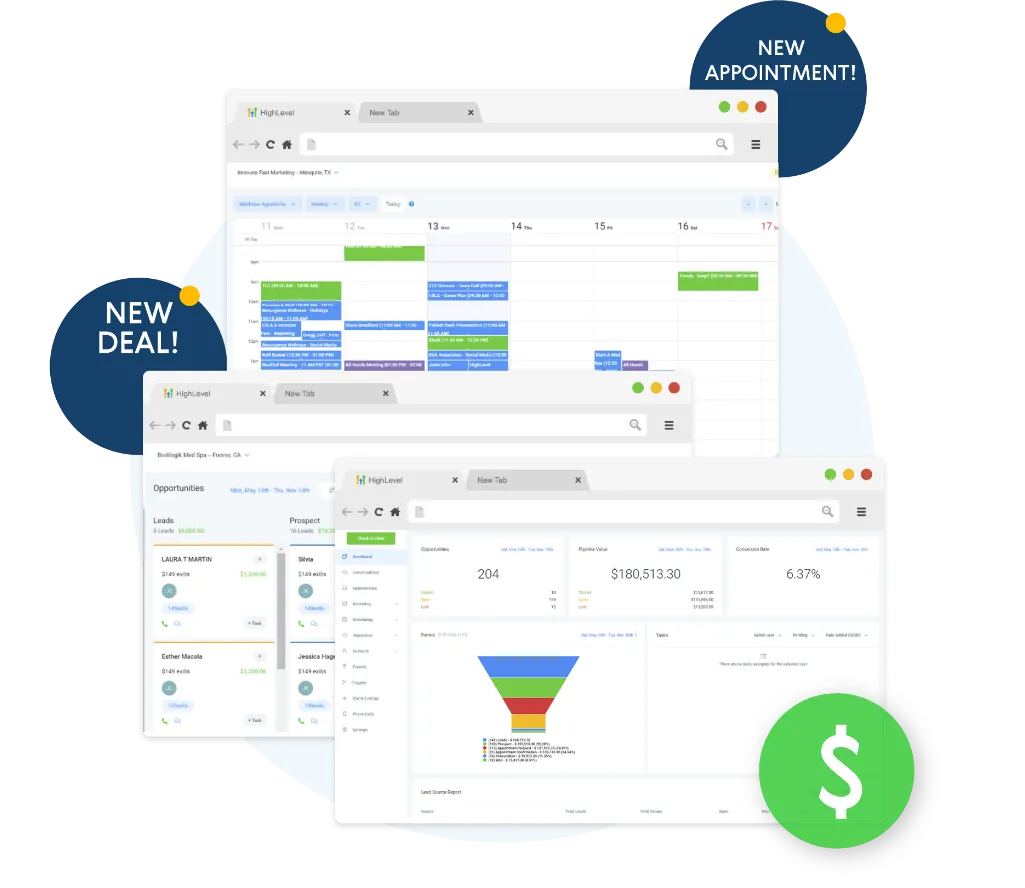We make it easy to know what your customers are doing. Think of all the places people talk to your business – on your website, in your store, or through email. A CRM system puts all these chats in one spot. It's like having a special notebook that shows what each person likes and what they do.
When someone buys from you or asks for help, the CRM keeps track. It tells you what makes them happy and what they want. This helps you give them better service. Your team can see this info too, so everyone knows how to help each customer best.
The CRM tells you right away if something needs to change. If lots of people say they don't like something, you can fix it fast. This makes people want to keep coming back to your business. It turns messy customer info into a clear picture that helps you serve them better.
Feeling overwhelmed by missed leads and disorganized workflows?
Discover the award-winning platform that automates follow-ups, tracks every lead, and keeps your business running smoothly—all in one place. Thousands of businesses are already transforming their sales and marketing with this trusted solution. Don’t miss out—start your 14-day free trial today and click now to uncover exclusive, limited-time special offers!
Understanding Modern Customer Journey Complexity

Helping customers today is very different than before. People now connect with businesses in many ways at once – on their phones, in stores, and online.
People know a lot more about what they want to buy. They look things up, stop to think, and change their minds often. What their friends say online and how much money they've affects their choices. Their feelings and trust in a business matter too.
To help customers better, we need to look at every time they talk to us or use our services. We must fix what bothers them and make things easy.
Each person is special and needs their own kind of help, no matter how they reach us.
Why Customer Journey Simplification Matters
Making things easier for customers helps businesses grow better. Companies that keep things simple make their customers happier than other companies do.
When you make it easy for customers, they don't have to work so hard to get what they want. Simple steps and clear paths help both customers and workers do better.
You can learn what works best by looking at what your customers do.
The results are big. When things are simple, customers stay longer and like your business more. You can also fix problems faster.
Best of all, you can give each customer what they really want, which makes them feel special.
Ready to simplify your business operations?
Streamline your workflows and boost productivity with a CRM designed to save you time and effort. From tracking leads to automating follow-ups, this platform does it all. Discover what’s possible—learn more about how it works and see why so many businesses rely on it every day.
CRM's Role in Journey Management

CRM helps us make customers happy by keeping track of what they need. Think of it as a friendly helper that watches how people use your business. It shows you what customers like and don't like, so you can make things better for them.
When you use CRM, everyone in your team can work together to help customers. It's like having a big map that shows you where each customer is on their path with your business. You can see what makes them smile and what bugs them.
The best part is that CRM tells you what works and what needs to be fixed. This helps you make smart choices to keep customers coming back.
Still struggling to keep your business organized?
Take the guesswork out of managing leads and follow-ups with a platform trusted by thousands of businesses. Say goodbye to missed opportunities and hello to a seamless sales process. Act now—try it free for 14 days and discover how easy it is to stay on top of your workflow. Don’t wait—exclusive offers won’t last long!
Mapping Customer Touchpoints With CRM
We track how customers connect with us online. This means watching what they do on our website, in emails, and on social media.
Our CRM tool helps us see all these actions in one place. We look at simple numbers like how many people click our links or buy our stuff.
When we know what works, we can make better choices about how to talk to our customers. This helps us be there for them in ways that matter most.
Digital Touchpoint Integration Strategy
We need to work together to reach our customers better.
Think about all the ways people talk to your business – like your website, social media, and store. These are your touchpoints.
Let's make a simple map of how people find and use your business.
We can use smart tools to connect the real world to the online world. Think of it like building bridges between different places where customers meet you.
Keep all customer info in one place.
This helps you know your customers better. When you understand what they like and don't like, you can fix problems faster. You can also give them what they want, when they want it.
Watch how people use your touchpoints.
This shows you what works and what needs to get better. The more you know about your customers, the better you can help them.
Remember: Make it easy for customers to talk to you, no matter how they reach out.
Keep things simple and friendly.
Measuring Cross-Channel Engagement Success
We want to know if our messages reach people across all the places they see us. It's like making sure we can talk to our friends whether we're at school, at the park, or on the phone.
First, we need to pick what we want to track. Think of it like checking if people read our notes or play with our toys. We use simple tools to see what people do when they visit us online or in stores.
We keep all this info in one big box – like a magic diary that remembers everything. This helps us see what works best when talking to people. We can then spend more time doing the things that make people happy and less time on stuff they don't care about.
We look at which ways people like to hear from us the most. Maybe they love our email stories but don't care for our phone calls. This helps us talk to people in ways they enjoy most.
Data-Driven Customer Experience Enhancement

We want to make customers happier by using data smartly. When we look at what our customers do and like, we can give them better help. Think of it like getting to know a friend.
By keeping all customer information in one place, we see the full story of how people use our service. This helps us treat each person in a way that fits them best. We can spot when someone needs help and fix problems fast.
We also watch what people buy and how they feel about us. This lets us change things quickly when needed. The more we learn about our customers, the better we can make their time with us.
Struggling to keep up with your growing business?
Simplify your processes and stay ahead with a CRM that adapts to your needs. Manage leads, automate tasks, and focus on what matters most—growing your business. Take the first step—explore the features today and see how it can transform the way you work.
Building Unified Customer Profiles
We want to know our customers better. Think of it like making a special book about each person who buys from us. This book has all the things they like and do.
To make these books, we collect info from many places. We look at what they buy in our stores. We see what they do on our website. We check what they say on social media. We also write down what they tell us when we talk to them.
We keep all this info in one safe place called a CRM. It's like a big digital file cabinet.
When someone in our team needs to learn about a customer, they can find everything in one spot. This helps us send the right messages to the right people. It also helps us make our customers happy.
Personalization Through CRM Technology

Getting to know your customers better is easy with CRM tools. These tools help you send the right message to the right person at the right time. You can make each customer feel special by showing them things they care about.
Here's what you can do with CRM tools:
- Set up smart messages that go out when customers do something
- Split your customers into groups based on who they're and what they like
- Change what people see based on what they do on your site
- Look at how well your messages work by checking the numbers
When you use these tools the right way, your customers will feel like you know them. This makes them happy and want to stay with you. They'll see the same friendly face of your business no matter where they find you.
Journey Optimization Best Practices
We want to make your customers' experience better. By looking at how people use your service, we can find and fix any problems they face.
When customers reach out to you – by phone, computer, or in person – they should get the same great help.
Watch both the numbers and what people say about their experience. This helps make the journey smoother and more people will want to buy from you.
Data-Driven Path Refinement
We help make customer journeys better by looking at what works and what doesn't. Just like checking a map to find the best way home, we use real data to see how people use our services.
We:
- Look at how customers move through their journey
- Learn about different types of customers
- Try new ideas to see what works best
- Ask customers what they think and make things better
When we watch and listen to what customers do, we can fix problems faster. This helps us give people what they want while helping our business grow.
The key is to use what we learn from real customer actions. Think of it like following footprints in the sand – they show us the path that people really take, not just the one we think they should take.
Seamless Channel Integration
Let's bring all our customer help tools together to serve people better. First, gather all customer info in one place. This helps us know what each person needs when they reach out.
We can fix tech problems by using tools that work well together. When teams share info, they can help customers faster. Look at what your best customers like, and use smart computer tools to spot patterns.
Always put customers first. Watch how they use your services and find ways to make things easier. Use friendly chat helpers to answer questions right away.
Listen to what customers say and make things better based on their ideas.
Real-Time Customer Journey Orchestration

We want to help customers at the exact moment they need us. Think of it like having a friendly guide who knows just what you want.
We watch how you use our services and learn what you like. This helps us give you better help right away.
To make this work well, we need to:
- Gather info from all the ways you talk to us
- Use smart tools to understand your needs
- Make sure you get the same good service everywhere
- React fast when you do something
We use simple tools to make your time with us better. When you click, we respond.
When you need help, we're there. It's that simple.
CRM Analytics and Journey Insights
We look at how your customers act and what they need. We watch them now and use what we learned from the past. This helps us make smart choices for you.
Our simple charts show you what works and what doesn't. You can see how people use your website, apps, and stores all at once.
We can also guess what your customers will want next. This lets us give each person the right help at the right time.
Data-Driven Decision Making
We can help customers better by looking at how they use our services. Smart tools show us what people like and don't like when they work with us.
- Look at what customers do to find ways to help them
- Try new ideas and see if they work better
- Learn from past visits to know what people might want next time
- Send the right messages to the right people
The tools we use make it easy to see problems fast. This helps us fix issues before they get big.
When we know more about our customers, we can give them what they need.
Real-Time Journey Optimization
We watch how customers interact with us and make their experience better as they go. We look at what they do on our website, emails, and other places they connect with us. This helps us send them the right messages at the right time.
Our smart tools help us give each customer what they need. We can see where customers get stuck and fix those spots quickly. Special charts show us how people move through their journey with us.
We also track how they read our emails and use this info to make every step better. We learn from what works and what doesn't. This helps us make sure customers are happy and get what they want.
When we see something isn't working well, we can change it fast to help customers reach their goals.
Predictive Behavior Analysis
Understanding What Your Customers Will Do
We can help you know what customers might do before they do it. This helps you keep them happy and make your business grow. We look at how people act and use smart tools to learn from it.
Think of it like reading a story. When you know how the story usually goes, you can guess what happens next. We do this with customer actions.
Here's what you need to do:
- Watch for signs that tell you if a customer might leave
- Learn about the steps customers take when they use your service
- Send the right message to each customer at the right time
- Keep track of how happy your customers are and fix problems fast
When you know these things, you can give customers what they want before they ask for it.
Measuring Journey Simplification Success

We can tell if our changes make things easier by looking at simple numbers. We need to watch both how well we work and if customers are happy.
Here are the things we count:
| What We Track | What We Look At |
|---|---|
| People Using It | Who comes to training, who uses the system |
| How Customers Feel | Are they happy, do they stay with us |
| How We Work | Is our info right, do things run well |
| Money Results | What we sell, what it costs to get customers |
Keep an eye on how each step works, and look at the big picture too. Watch for signs that show if things are going well or not. Make sure it's easy for customers to help themselves online.
Look at the numbers to see what works best at different times of the year. This helps us make smart changes to make things better for each group of customers.
Conclusion
CRM helps make customer journeys easier for everyone. When businesses use CRM tools, they can see how happy their customers are. In fact, customers are 23% happier when companies use CRM to guide them. CRM lets you see what works best for your customers. It helps you make their path smoother and better. This makes customers want to come back, and it helps your team work faster too.








